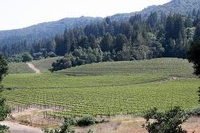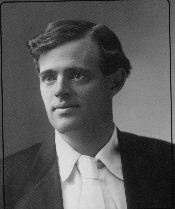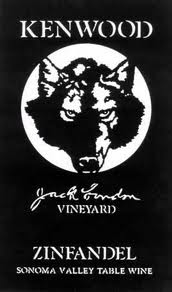When I asked J. Patrick Henderson, senior winemaker for Kenwood Vineyards what he considers unique about the environment of the Jack London Vineyard, his answer spoke to an intimacy with the land: “It’s the soil, the layer of gray volcanic ash that forms the top layer…and the altitude, about 600 feet above sea level, placing the vines above most of the morning fog.”
altitude, about 600 feet above sea level, placing the vines above most of the morning fog.”
No doubt, these natural factors are the key to quality grapes from the Jack London Vineyard, in the western hills of Sonoma Valley. But I had hoped for a less technical description, one that might conjure up the ghost of Jack London riding his horse across the land he came to love. “There are 130 acres in the place, and they are 130 acres of the most beautiful, primitive land to be found in California,” London wrote in a letter to a friend. I should have known, though, that if you ask a pragmatic question, you’re not likely to get a poetic answer.
London came to Sonoma Valley in 1903 to court Charmian Kittredge and discovered a piece of land that captured his imagination. He was on a high that year, having just established his reputation, as a premier American author, with the publishing of Call of the Wild, an adventure novel that expanded the limits of Americans’ imagination about wildlife and the north. Two years later, he and Kittredge were married, and  London purchased the Hill Ranch on Sonoma Mountain. Over the next eight years, London bought adjacent ranches, creating the 1,400 acre Beauty Ranch. It was from this peaceful hillside ranch that London drew inspiration for several of his books, including The Valley of the Moon, a name that would come to aptly describe Sonoma Valley.
London purchased the Hill Ranch on Sonoma Mountain. Over the next eight years, London bought adjacent ranches, creating the 1,400 acre Beauty Ranch. It was from this peaceful hillside ranch that London drew inspiration for several of his books, including The Valley of the Moon, a name that would come to aptly describe Sonoma Valley.
A vineyard had already been planted on the land when London began to develop Beauty Ranch. After his untimely death in 1916, the Beauty Ranch was managed by his sister-in-law, Eliza Shepard, until 1959 when the London family donated land for the establishment of Jack London State Park. This brings the story to 1972, when Eliza’s son, Milo Shepard, at the urging of August Sebastiani, planted the Jack London Vineyard on the Hill Ranch portion of the estate, much of it on terraces built by London. Except for a 200-acre plot that Milo Shepard held onto, the remainder of the original Hill Ranch land was donated to the state park. Shepard died at his home on the ranch last October at the age of 84, after a long illness.
Today, Jack London Vineyard is a network of 14 blocks, planted to Cabernet Sauvignon and Merlot, plus smaller blocks of Zinfandel, Cabernet Franc and Syrah. Henderson says the key to Jack London grapes is good structured tannins, especially for Merlot. “The Merlot is not soft or insipid. All five of the varieties grown in the Jack London Vineyard benefit from being above the fog, so there’s plenty of morning sun, but the flavors are never cooked and there are good acids from the cool nights.” Henderson often detects a subtle spearmint note in Jack London Cabernet Sauvignon, which he contributes to eucalypt trees planted at the edges of the vineyard plots.
In recent years, Kenwood has settled on the three Bordeaux red grapes, Zinfandel and Syrah for the Jack London Vineyard. But Henderson says that Cabernet Franc will be phased out and Syrah is loosing interest. “Syrah was the last variety planted in Jack London, we only have five acres and we make very little of it, preferring to blend a little Syrah in our Zinfandel,” he says. In fact, two Zinfandel blocks were among the first to be planted when Shepard established the vineyard in 1972. Henderson says that about 10 acres of Merlot has been replanted to Zinfandel. “For Kenwood, there is more interest in  Zinfandel than Merlot.”
Zinfandel than Merlot.”
Since 1977, Kenwood Vineyards has had an exclusive contract for the fruit from the Jack London Vineyard and that same year, Kenwood’s former winemaker, Mike Lee established the first Jack London Vineyard designated wine. Prior to Kenwood locking up the Jack London grape contract, Henderson believes that Lee purchased some Jack London Cabernet, but Chateau St. Jean was the first to make a vineyard designated Jack London Cabernet Sauvignon from the 1976 vintage.
All four of the Jack London single vineyard varietals carry the distinctive London wolf head logo above a facsimile Jack London signature. During a recent visit to the Jack London vineyard, I asked Henderson how much of a difference that one-percent of Merlot makes to ninety-nine percent Cabernet Sauvignon, the blend in the current release 2007 Jack London Cabernet Sauvignon.
“For blending wines the differences between small percentages may not seem like much but they are discernable. I like to use the subtle shading in paint as an analogy. The walls in my office just look white to me, but I know from visiting a paint store that there are hundreds of shades of white with subtle differences. You cannot really see the differences in the shades of white until you see them side by side. The same is true with wine when we conduct blending trials. We try various percentages and see which one we like best and often the favorite is a difference of only one percent.” To further illustrate his point, Henderson points out that the 2007 Jack London Merlot is blended with 2% Cabernet Sauvignon.
Henderson says that, with the exception of time in oak and a few different blends, winemaking for the Jack London wines doesn’t vary much from the varietals in Kenwood’s regular Sonoma Valley line. All are fermented in stainless steel and then placed in barrels for aging. Except for the Syrah that is aged exclusively in French oak, the other three Jack London wines mature in a mix of French and American oak barrels from 18 to 20 months.
Sonoma Mountain red wines have earned a reputation for power and intensity, while Kenwood’s Jack London reds speak more to subtlety and carefully modulated power. Try the Jack London Cabernet Sauvignon and see for yourself.